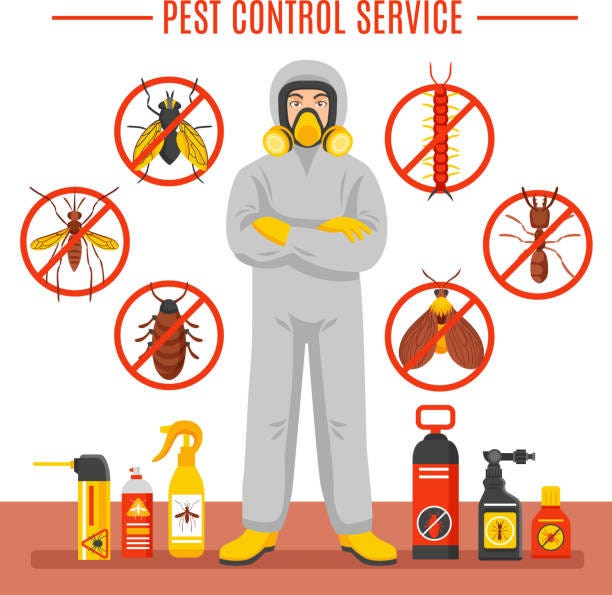Top Quality A1 Pest Control Services Charlotte - Secure Your Home
Top Quality A1 Pest Control Services Charlotte - Secure Your Home
Blog Article
Bed Insect Therapy Failure: Contrasting Chemical Vs. Non-Chemical Solutions
In the realm of parasite control, specifically when dealing with the relentless concern of bed pests, the selection between chemical and non-chemical therapy solutions can be an essential one. Both strategies provide distinct advantages and drawbacks, influencing elements such as efficiency, safety and security factors to consider, and total price. By examining the nuanced details of each approach, a clearer understanding of which path to pursue in resolving a bed pest infestation can be achieved.
Effectiveness of Chemical Treatments
Chemical therapies for bed bug invasions have been commonly acknowledged for their powerful and quick efficacy in eliminating these insects. When taking into consideration the effectiveness of chemical treatments, it is crucial to comprehend that they can supply a fast and thorough service to a bed bug issue. Expert exterminators typically count on pesticides to target bed bugs at numerous stages of their life cycle, including grownups, nymphs, and eggs. These chemicals typically function by interrupting the bed bugs' nerves, bring about paralysis and ultimate fatality.
Additionally, chemical treatments have the advantage of supplying residual effects, suggesting that they can proceed to remove bed pests also after the first application. This residual activity is especially useful in combating any possible re-infestations. Additionally, the fast activity of chemical therapies can bring relief to individuals encountering extreme bed pest infestations, enabling them to reclaim control of their living spaces promptly.
Safety And Security Worry About Chemical Solutions
One essential aspect that calls for mindful factor to consider when using chemical services for bed pest treatment is making sure the security of residents and the atmosphere. Exposure to specific chemicals utilized in bed insect therapies can lead to respiratory concerns, skin inflammation, or various other damaging reactions, particularly in people with pre-existing problems or sensitivities.
Additionally, the ecological impact of chemical remedies is one more considerable factor to consider. Some pesticides made use of in bed insect treatments may be damaging to beneficial pests, wildlife, and ecological communities if they seep into the dirt or water systems. It is important to utilize chemical treatments sensibly, complying with safety and security guidelines, and taking into consideration much less harmful alternatives to mitigate these threats and ensure the risk-free and reliable administration of bed insect infestations.
Benefits of Non-Chemical Methods
Taking into consideration the prospective safety and security worries and ecological influence associated with chemical services for bed pest therapy, exploring non-chemical techniques offers an appealing alternative with several unique advantages. Non-chemical therapies are environmentally pleasant, as they do not add to air or water pollution, making them a sustainable choice for pest control.
In addition, non-chemical services can be reliable in targeting bed insects, consisting of hard-to-reach locations where chemical therapies discover this may not permeate - A1 bed bug exterminator charlotte. Techniques such as heat treatment, vacuuming, vapor cleansing, and mattress encasements offer thorough elimination without the usage of damaging chemicals.
Limitations of Non-Chemical Treatments

In addition, non-chemical therapies often require several applications to attain effective eradication. This can be lengthy and might not constantly ensure full removal of all bed insects and their eggs, especially in concealed or hard-to-reach locations.
Moreover, the success of non-chemical therapies heavily depends on proper execution and thoroughness, which can be testing for individuals without specialist proficiency. Insufficient application of non-chemical methods may cause insufficient obliteration, causing persistent blog here infestations and the need for additional treatments.
For that reason, while non-chemical treatments have their advantages, it is necessary to recognize these restrictions and consider them when identifying one of the most efficient pop over to this site approach for managing bed pest infestations.
Cost Comparison: Chemical Vs. Non-Chemical Options
Given the limitations connected with non-chemical therapies, a vital aspect to assess in the context of bed insect administration is the price comparison in between chemical and non-chemical options. Chemical therapies commonly include the application of pesticides by professionals, which can vary from $250 to $900 per space, relying on the extent of the infestation and the size of the location to be dealt with. On the other hand, non-chemical therapies like warmth treatment or heavy steam can be a lot more pricey, with costs varying from $1,000 to $6,000 for a whole home. While the first price of chemical therapies might seem lower, numerous therapies might be required to completely eliminate the problem, potentially raising the general price. On the various other hand, non-chemical choices may offer a more sustainable and environmentally friendly option, although they can be cost-prohibitive for some people. Inevitably, when thinking about the price of bed bug treatment options, it is crucial to consider the ahead of time expenditures against the performance and long-term sustainability of the picked technique.
Final Thought

Thinking about the potential safety and security issues and environmental impact linked with chemical solutions for bed insect therapy, discovering non-chemical methods provides a promising alternative with several distinct advantages.Provided the constraints associated with non-chemical treatments, an essential element to review in the context of bed pest monitoring is the expense contrast in between chemical and non-chemical choices. In comparison, non-chemical treatments like warm treatment or vapor can be a lot more costly, with costs varying from $1,000 to $6,000 for a whole home. While the preliminary price of chemical treatments might appear reduced, several treatments might be needed to totally eliminate the infestation, possibly boosting the general cost.In conclusion, when comparing chemical and non-chemical bed pest treatment alternatives, it is important to think about efficiency, safety and security, advantages, restrictions, and cost.
Report this page